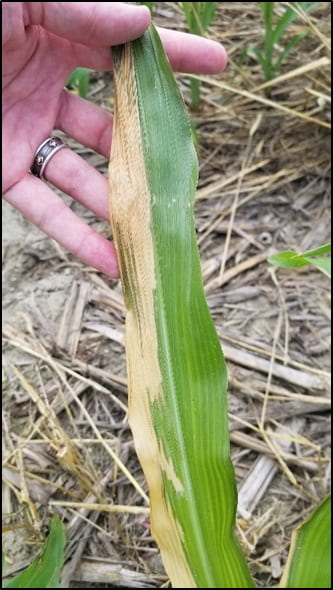Jarrod O. Miller, Extension Agronomist, jarrod@udel.edu
Salts are a natural component of soils, including our soluble plant nutrients (Ca, NO3, etc.). Excessive levels of any salt can be detrimental to both plant health and soil quality. On the Delmarva Peninsula, excessive salts can come through several sources, which include fertilizers, irrigation water, and salt water intrusion.
Issues with fertilizers are related to seed germination and growth, where in-furrow recommendations of starter N+K fertilizers are limited to 10 lb/acre total due to salt effects. During sidedress applications, fertilizer burn (Figure 1) can damage leaf tissue, particularly UAN greater than 50lb/acre. As long as corn plants are younger, minimal tissue damage doesn’t affect yield. Considering the above recommendations, salt damage due to fertilizers should be easy to manage.
Figure 1. Some fertilizer burn to corn leaf tissue during sidedress application.
Many of the nutrients that leach from our soils, particularly anions like NO3 and SO4, will end up in groundwater. Therefore, most irrigation water will contain some level of salts, which in drier, western climates will build up in the soil. On the Delmarva, we receive enough rainfall to help wash excess salts from the root zone. However, in some cases, irrigation water near coastlines (or wastewater applications) may add appreciable levels of salts. A similar issue extends from coastal flooding, where ground and surface waters may become inundated with salts at levels difficult to leach through rainwater alone.
The type of salt added makes a difference in soil and plant responses. Sodium is not considered an essential plant nutrient and can be considered toxic at higher concentrations. Calcium and magnesium are essential plant nutrients, but at high concentrations, they can prevent the plant from absorbing moisture from the soil. Both Ca and Mg are cations, but these soils will also contain their anion equivalent in the form of Cl or SO4. This is why typical literature on remediating salts differentiate between saline (excess salts, e.g. Na, Ca, SO4) and sodic soils (excess Na). Knowing the difference is important in determining remediation.
Any well drained soil that received excess Na can easily be remediated using gypsum (CaSO4) in addition to precipitation or irrigation. Sodium may cause crusting of the soil surface, preventing water percolation, however levels in DE are often not that high. Excessive salts that include Ca and Mg are not easily remedied with gypsum, which simply adds more Ca to the soil. These soils will require rainfall or irrigation that contains lower salt levels than the soil itself. This problem can be compounded in low lying areas, where high water tables prevent soil drainage.
If you suspect salts are an issue in your soils, a soil test can help determine the best method for remediation. However, the standard definitions of saline and sodic soils are based on a paste extraction compared to the Mehlich3 used at most of our regional labs. To perform calculations such as the sodium absorption ratio (SAR), we would need to correlate those values to regional testing. The exchangeable sodium percentage (ESP), like the amount of Na on the CEC, is considered “sodic” above 15%, but is also not correlated to regional soil tests. It may be better to consider typical Na values across our soils, which are often in the 1-3% range on the CEC. Fields that creep above this level should be watched for salt toxicity, and if saline waste or irrigation water is being added, consider fall gypsum treatments to remediate.
Figure 2. Low lying coastal lands may experience salt water intrusion, to the detriment of any plant growth in some parts of the soil.


